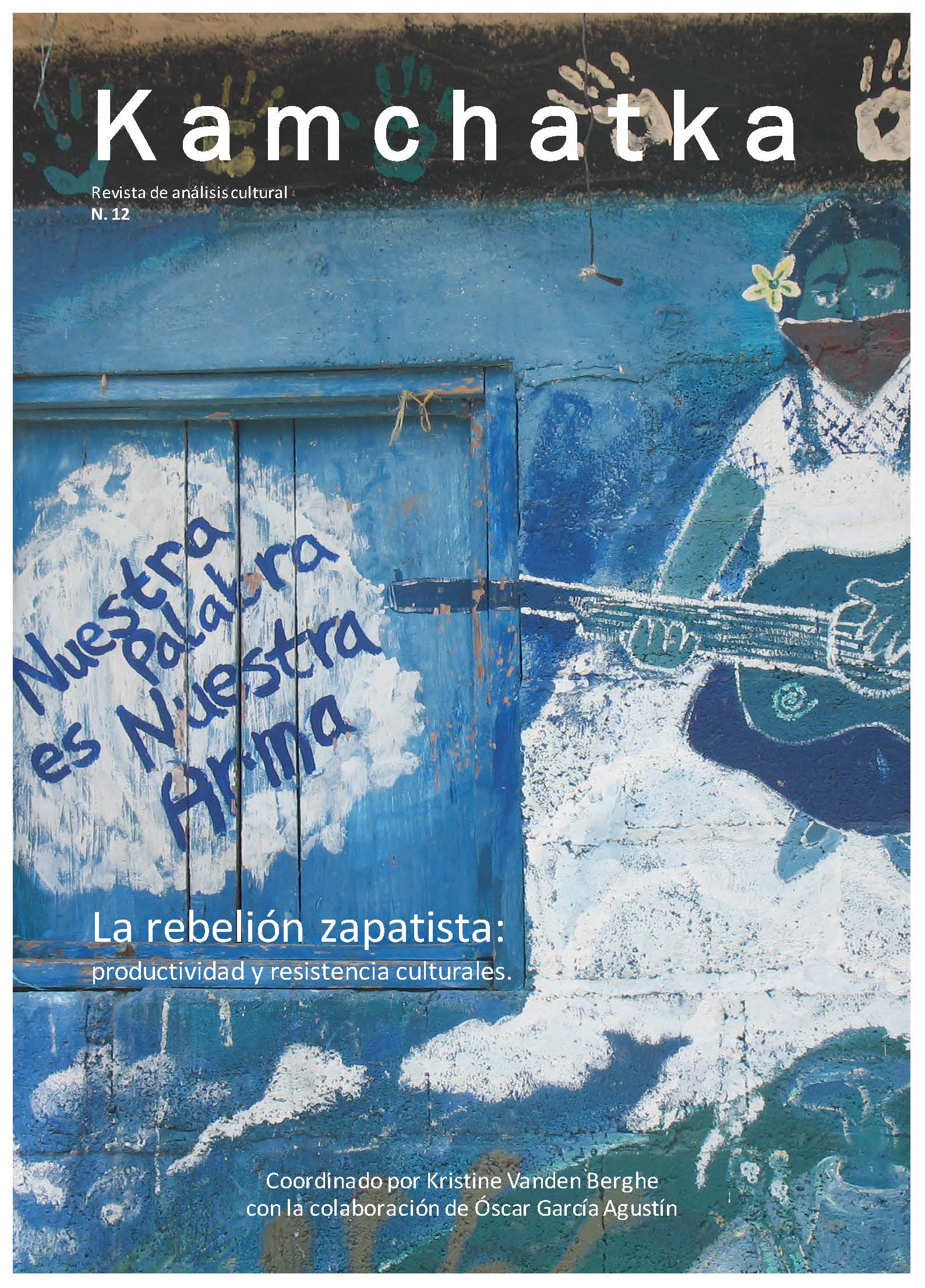The Neozapatista identity as a communicative process
DOI:
https://doi.org/10.7203/KAM.12.12366Keywords:
Mexico, Discourse, Political Action, Subcomandante Insurgente Marcos, Neozapatism Abstract
Abstract
This article studies the speech and the political action of the Zapatista movement, considering both as a communicative practice that is articulated among a plurality of uses and “cultural matrices” (Martín Barbero, 1987) in what has constituted the Neozapatista social subject. Firstly, the discursive aspects of the Zapatista statements are reviewed, with their narrative strategies, key representations and conditions of reproduction. Secondly, an emphasis is made on the systematic study of its political-media trajectory throughout its already long history, analyzing the conventions, the encounters and other Zapatista actions and political initiatives. The results offer an overview about the identity construction of a social subject of polysemic nature that forges itself to the heat of a communicative process that lies with a plurality of groups and individuals of various nature.
 Downloads
Downloads
 References
References
Anderson, Benedict (1993). Comunidades imaginadas. México: Fondo de Cultura Económica.
Arellano Sánchez, José y Santoyo Rodríguez, Margarita. “Los nuevos sujetos sociales del Neozapatismo”. Convergencia, 24 (2001): 91-139.
Aubry, Andrés (2005). Chiapas a contrapelo. Una agenda de trabajo para la historia de Chiapas en perspectiva sistémica. México: Contrahistorias.
Barthes, Roland (1987). El susurro del lenguaje. Más allá de la palabra y la escritura. Barcelona: Paidós.
Barthes, Roland (1996). El grado cero de la escritura. México: Siglo XXI.
Baschet, Jérôme (2005). La rébellion zapatiste. Paris: Flammarion.
Bonfil Batalla, Guillermo (1990). México profundo. Una civilización negada. México: Grijalbo.
Castells, Manuel (1999). La era de la información. México: Siglo XXI.
Cerda García, Alejandro (2011). Imaginando zapatismo: multiculturalidad y autonomía indígena en Chiapas desde un municipio autónomo. México: UAM/Miguel Ángel Porrúa.
Cleaver, Harry. “The Zapatista Effect: The Internet and the Rise of an Alternative Political Fabric”. Journal of International Affairs Editorial Board, 51(2) (1998): 621-640.
Cruces, Francisco. “Matrices culturales: pluralidad, emoción y reconocimiento”. Anthropos: huellas del conocimiento, 219 (2008): 173-179.
Diani, Mario. “The concept of social movement”. The Sociological Review, 40 (1) (1992): 1-25.
Flores Quintero, Genoveva (2004). La seducción de Marcos a la prensa. Versiones sobre el levantamiento zapatista. México: Ángel Porrúa.
Gadea, Carlos (2004). Acciones colectivas y modernidad global. El movimiento neozapatista. México: Universidad Autónoma del Estado de México.
García Canclini, Néstor (2004). Diferentes, desiguales y desconectados. Mapas de la interculturalidad. Barcelona: Gedisa.
García de león, Antonio (1994). “Prólogo”. EZLN, Documentos y comunicados I. México: Era.
Gilly, Adolfo (1997). Chiapas: la razón ardiente: ensayo sobre la rebelión del mundo encantado. México: Era.
Habermas, Jürgen (2002). Verdad y justificación. Madrid: Trotta.
Harvey, Neil (2000). La rebelión de Chiapas. La lucha por la tierra y la democracia. México: Era.
Harvey, Neil. “Practicando la autonomía: el zapatismo y la liberación decolonial”. El Cotidiano, 200 (2016): 7-19.
Jakobson, Roman (2003). Les fondations du langage. Essais de linguistique générale I. Paris: Minuit col. Poche.
Laclau, Ernesto y Mouffe, Chantal (2015). Hegemonía y estrategia socialista: hacia una radicalización de la democracia. Madrid: Siglo XX.
Leetoy, Salvador. “Otras globalizaciones posibles: movimientos sociales altermundialistas y la ruta hacia el sujeto cultural indígena internacional”. CONfines, 7 (14) (2011): 13-42.
Leyva Solano, Xóchitl y Sonnleitner, Willibald. “¿Qué es el neozapatismo?”. Espiral, 6 (17) (2000): 163-202.
Martín-Barbero, Jesús (1987). De los medios a las mediaciones. México: Gustavo Gili.
McCombs, Maxwell E. y Shaw, Donald. “The agenda-setting function of mass media”. Public Opinion Quarterly, 36 (2) (1972): 176-187.
Meneses C., Aldo; Demanet, Alain; Baeza, Constanza; Castillo, Javier. “El movimiento zapatista: impacto político de un discurso en construcción”. Enfoques: Ciencia, Política y Administración Pública, 10 (16) (2012): 151-174.
Mignolo, Walter. “La revolución teórica del zapatismo: sus consecuencias históricas, éticas y políticas”. Orbis Tertius, 2 (5) (1997).
Monsiváis, Carlos (2003). EZLN, Documentos y comunicados IV. México: Era.
Montemayor, Carlos. “La marcha zapatista”. La Jornada (12/09/1997).
Rojas, Rosa (1995). Chiapas, la paz violenta. México: La Jornada.
Tello, Carlos (1995). La rebelión de las cañadas. México: Cal y Arena.
Trejo Delarbre, Raúl (1994). Chiapas, la comunicación enmascarada. Los medios y el pasamontañas. México: Diana.
Touraine, Alain (2000). ¿Podremos vivir juntos? Madrid: Fondo de Cultura Económica.
Touraine, Alain (2005). Un nuevo paradigma para comprender el mundo de hoy. Barcelona: Paidós.
Vázquez Montalbán, Manuel (2001). Marcos: el señor de los espejos. México: Punto de lectura.
Zibechi, Raúl (2012). Territorios en resistencia. Cartografía política de las periferias urbanas latinoamericanas. Málaga: Zambra.
Downloads
Published
How to Cite
-
Abstract1003
-
Artículo (Español)910
Issue
Section
License
This journal provides an immediate free access to the content on the principle that freely make investigation available to the public, which promotes an increased global knowledge exchange.
Unless otherwise indicated, texts published in this journal are under the license Attribution-NonComercial 4.0 by Creative Commons. These texts may be copied, distributed and publicly communicated whenever the publication’s author and title are quoted and whenever they are not used for commercial purposes. In any case, intellectual property of the articles and its potential economic rights entirely belong to its authors.
The full license can be consulted on https://creativecommons.org/licenses/by-nc/4.0/. We encourage authors to disseminate papers published in Kamchatka. Journal of cultural analysis electronically, in institutional digital repository or in their websites.





